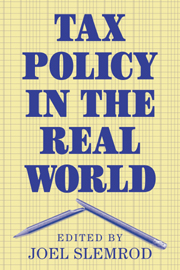Book contents
- Frontmatter
- Contents
- List of contributors
- 1 The real world of tax policy
- 2 Federal tax reform
- 3 Federalism and subfederal taxes
- Threading the fiscal labyrinth: some issues in fiscal decentralization
- A policymaker's guide to fiscal decentralization
- Fiscal decentralization and economic development
- Federalism and reductions in the federal budget
- Issues raised by the new federalism
- Fiscal equalization and school finance
- The case for equalizing aid
- Fiscal equalization: an empty box?
- How would you know a good economic development policy if you tripped over one? Hint: don't just count jobs
- Jobs, productivity, and local economic development: what implications does economic research have for the role of government?
- 4 Principles, politics, and the professors
- Index
Fiscal equalization and school finance
Published online by Cambridge University Press: 01 June 2010
- Frontmatter
- Contents
- List of contributors
- 1 The real world of tax policy
- 2 Federal tax reform
- 3 Federalism and subfederal taxes
- Threading the fiscal labyrinth: some issues in fiscal decentralization
- A policymaker's guide to fiscal decentralization
- Fiscal decentralization and economic development
- Federalism and reductions in the federal budget
- Issues raised by the new federalism
- Fiscal equalization and school finance
- The case for equalizing aid
- Fiscal equalization: an empty box?
- How would you know a good economic development policy if you tripped over one? Hint: don't just count jobs
- Jobs, productivity, and local economic development: what implications does economic research have for the role of government?
- 4 Principles, politics, and the professors
- Index
Summary
There is a long tradition in the United States of local provision of elementary and secondary public education. In the early years of the nation, “public” education was financed primarily through voluntary contributions from local residents and from direct payments by parents. Only in the late nineteenth century did the responsibility for the provision and financing of public education come to rest entirely on local governmental bodies, and to rely primarily on revenues from local property taxes.
By the turn of the century, both scholars and public officials had begun to express concern about inequities across communities in the provision of public education. Along with the rapid industrialization of the country came a growing spatial variation in property wealth (Coons, Clune, and Sugarman, 1970). Although residents of property-poor communities could compensate for their lack of fiscal resources by taxing themselves at a higher rate, the spatial differences in property tax base were so large that spending per pupil on public schools was in most states highly correlated with per-pupil property wealth. This pattern of spending differences led to a call for state intervention in the financing of public education. In the early years of the century, a number of states responded by providing equal per-pupil (flat) grants. This began the long history of attempts by state governments at fiscal equalization in the financing of public education. In this paper, I spell out the objectives of these fiscal equalization efforts and assess the effectiveness of the mechanisms put in place to achieve fiscal equalization.
- Type
- Chapter
- Information
- Tax Policy in the Real World , pp. 209 - 222Publisher: Cambridge University PressPrint publication year: 1999



